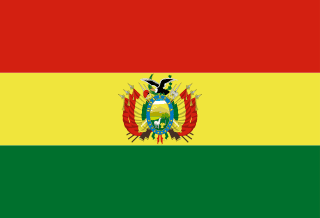Bolivia - Government

Based on the etymolgy of Bolivia, it was the country is named in honor of Simón BOLÍVAR, a 19th-century leader in the South American wars for independence. The Government system in this country is the presidential republic type and the different Administrative divisions includes: 9 departments (departamentos, singular - departamento); Beni, Chuquisaca, Cochabamba, La Paz, Oruro, Pando, Potosi, Santa Cruz, Tarija
National symbols
Llama, Andean condor; two national flowers, the cantuta and the patuju.
The flag
The National flag of Bolivia has .
Info
The National Anthem
| Title | |
|---|---|
| Lyric/music |
Info
More about the government of Bolivia
| Date of Independence | 6 August 1825 (from Spain) |
|---|---|
| National holiday | Independence Day, 6 August (1825) |
| Legal system | civil law system with influences from Roman, Spanish, canon (religious), French, and ethnic groups' pre-colonial law |
| International law organization participation | has not submitted an ICJ jurisdiction declaration; accepts ICCt jurisdiction |
| Constitution | |
| History | Many previous; latest drafted 6 August 2006 to 9 December 2008, approved by referendum 25 January 2009, effective 7 February 2009 |
| Amendment process | Proposed through public petition by at least 20% of voters or by the Plurinational Legislative Assembly; passage requires approval by at least two-thirds majority vote of the total membership of the Assembly and approval in a referendum |
| Citizenship | |
| Citizenship by birth | yes |
| Citizenship by descent only | yes |
| Dual citizenship recognized | yes |
| Residency requirement for naturalization | 3 years |
| Executive Branch | |
| Chief of state | President Rodrigo PAZ Pereira (since 8 November 2025) |
| Head of government | President Rodrigo PAZ Pereira (since 8 November 2025) |
| Cabinet | Cabinet appointed by the president |
| Election/appointment process | president and vice president directly elected on the same ballot one of 3 ways: candidate wins at least 50% of the vote, or at least 40% of the vote and 10% more than the next highest candidate; otherwise, a second round is held and the winner determined by simple majority vote; president and vice president are elected by majority vote to serve a 5-year term; no term limits |
| Most recent election date | 17 August 2025 |
| Election results | 2025: Rodrigo PAZ Pereira elected president in second round; percent vote in first round - Rodrigo PAZ Pereira (PDC) 32.1%, Jorge Fernando QUIROGA Ramírez (LIBRE) 26.7%, Samuel DORIA MEDINA Auza (UN) 19.7%, Andrónico RODRÌGUEZ Ledezma (AP) 8.5%, Manfred REYES Villa (APB Súmate) 6.8%, Eduardo DEL CASTILLO (MAS) 3.2%, other 3%; percent of vote in second round - Rodrigo PAZ Pereira 55%, Jorge Fernando QUIROGA Ramírez 45% 2020: Luis Alberto ARCE Catacora elected president; percent of vote - Luis Alberto ARCE Catacora (MAS) 55.1%; Carlos Diego MESA Gisbert (CC) 28.8%; Luis Fernando CAMACHO Vaca (Creemos) 14%; other 2.1% 2019: Juan Evo MORALES Ayma reelected president; percent of vote - Juan Evo MORALES Ayma (MAS) 61%; Samuel DORIA MEDINA Arana (UN) 24.5%; Jorge QUIROGA Ramirez (POC) 9.1%; other 5.4% |
| Expected date of next election | 2030 |
| Legislative branch | |
| Legislature name | Plurinational Legislative Assembly (Asamblea Legislativa Plurinacional) |
| Legislative structure | Bicameral |
| Judicial branch | |
| Highest court(s) | Supreme Court or Tribunal Supremo de Justicia (consists of 12 judges organized into civil, penal, social, and administrative chambers); Plurinational Constitutional Tribunal (consists of 7 primary and 7 alternate magistrates); Plurinational Electoral Organ (consists of 7 members and 6 alternates); National Agro-Environment Court (consists of 5 primary and 5 alternate judges; Council of the Judiciary (consists of 3 primary and 3 alternate judges) |
| Judge selection and term of office | Supreme Court, Plurinational Constitutional Tribunal, National Agro-Environmental Court, and Council of the Judiciary candidates pre-selected by the Plurinational Legislative Assembly and elected by direct popular vote; judges elected for 6-year terms; Plurinational Electoral Organ judges appointed - 6 by the Legislative Assembly and 1 by the president of the republic; members serve single 6-year terms |
| Subordinate courts | National Electoral Court; District Courts (in each of the 9 administrative departments); agro-environmental lower courts |
| Diplomatic representation in the US | |
| Chief of mission | Ambassador (vacant); Chargé d'Affaires Henry BALDELOMAR CHÁVEZ (since 11 October 2023) |
| Chancery | 3014 Massachusetts Ave., NW, Washington, DC 20008 |
| Telephone | [1] (202) 483-4410 |
| FAX | [1] (202) 328-3712 |
| Email address and website | [email protected] https://www.boliviawdc.org/en-us/ |
| Consulate(s) general | Houston, Los Angeles, Miami, New York |
| Diplomatic representation from the US | |
| Chief of mission | Ambassador (vacant); Chargé d'Affaires Debra HEVIA (since September 2023) |
| Embassy | Avenida Arce 2780, Casilla 425, La Paz |
| Mailing address | 3220 La Paz Place, Washington DC 20512-3220 |
| Telephone | [591] (2) 216-8000 |
| FAX | [591] (2) 216-8111 |
| Email address and website | [email protected] https://bo.usembassy.gov/ |
| National heritage | |
| Total World Heritage Sites | 7 (6 cultural, 1 natural) |
| Selected World Heritage Site locales | City of Potosi (c); El Fuerte de Samaipata (c); Historic Sucre (c); Jesuit Missions of Chiquitos (c); Noel Kempff Mercado National Park (n); Tiahuanacu (c); Qhapaq Ñan/Andean Road System (c) |
Key Political parties and their leaders in Bolivia
Info
International organization participation
All Important Facts about Bolivia
Want to know more about Bolivia? Check all different factbooks for Bolivia below.









